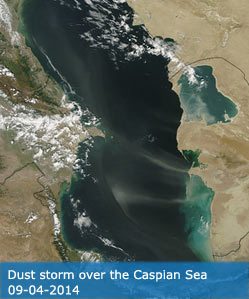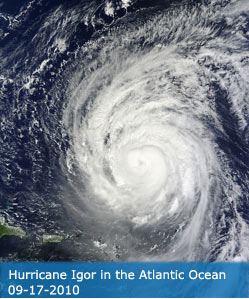Images
September 7, 2021 - Lakes Michigan and Huron
Tweet
On September 2, 2021, the Moderate Resolution Imaging Spectroradiometer (MODIS) on board NASA’s Terra satellite acquired a true-color image centered on Lake Michigan and Lake Huron.
Lake Michigan, in the west, is the only one of the five Great Lakes that sits fully within the United States. All others, including Lake Huron, are shared with Canada. At the northern end of the lakes, Lake Michigan and Lake Huron are connected by a narrow channel. Measuring only 4 to 5 miles wide (4.6 – 8 km), the Straits of Mackinac allow water to flow between both of the lakes and is the primary reason that Lakes Huron and Michigan are considered one giant lake, hydrologically speaking. A small portion of western Lake Erie can also be seen in the lower right (southeast) section of this image.
The brilliant streaks of green that colors Lake Huron’s Saginaw Bay, western Lake Erie, and the small Lake St. Clair (between Lakes Huron and Erie) are most likely caused by blooms of microscopic organisms. One common type of bloom is caused by cyanobacteria. Often referred to as “blue-green algae”, cyanobacteria are not actually algae, but are bacteria. They thrive in warm, nutrient-rich water such as found in these three locations from mid-summer though October. Certain types of cyanobacteria can produce toxins that are linked to illnesses in humans and animals.
Image Facts
Satellite:
Terra
Date Acquired: 9/2/2021
Resolutions:
1km (1.3 MB), 500m (1.9 MB), 250m (4.8 MB)
Bands Used: 1,4,3
Image Credit:
MODIS Land Rapid Response Team, NASA GSFC
Tweet
On September 2, 2021, the Moderate Resolution Imaging Spectroradiometer (MODIS) on board NASA’s Terra satellite acquired a true-color image centered on Lake Michigan and Lake Huron.
Lake Michigan, in the west, is the only one of the five Great Lakes that sits fully within the United States. All others, including Lake Huron, are shared with Canada. At the northern end of the lakes, Lake Michigan and Lake Huron are connected by a narrow channel. Measuring only 4 to 5 miles wide (4.6 – 8 km), the Straits of Mackinac allow water to flow between both of the lakes and is the primary reason that Lakes Huron and Michigan are considered one giant lake, hydrologically speaking. A small portion of western Lake Erie can also be seen in the lower right (southeast) section of this image.
The brilliant streaks of green that colors Lake Huron’s Saginaw Bay, western Lake Erie, and the small Lake St. Clair (between Lakes Huron and Erie) are most likely caused by blooms of microscopic organisms. One common type of bloom is caused by cyanobacteria. Often referred to as “blue-green algae”, cyanobacteria are not actually algae, but are bacteria. They thrive in warm, nutrient-rich water such as found in these three locations from mid-summer though October. Certain types of cyanobacteria can produce toxins that are linked to illnesses in humans and animals.
Image Facts
Satellite:
Terra
Date Acquired: 9/2/2021
Resolutions:
1km (1.3 MB), 500m (1.9 MB), 250m (4.8 MB)
Bands Used: 1,4,3
Image Credit:
MODIS Land Rapid Response Team, NASA GSFC




